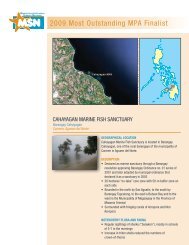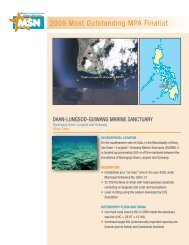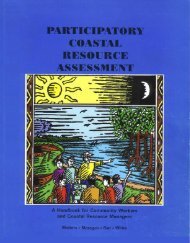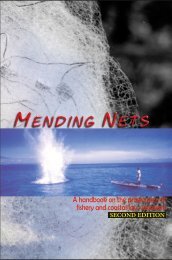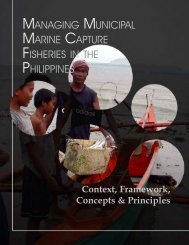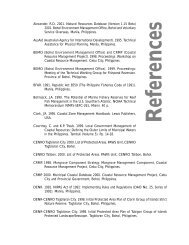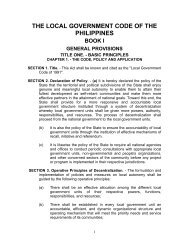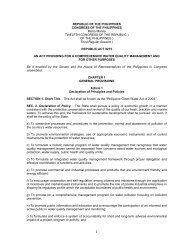Effectiveness of Marine Protected Areas in the Philippines for ...
Effectiveness of Marine Protected Areas in the Philippines for ...
Effectiveness of Marine Protected Areas in the Philippines for ...
Create successful ePaper yourself
Turn your PDF publications into a flip-book with our unique Google optimized e-Paper software.
8 <strong>Effectiveness</strong> <strong>of</strong> <strong>Mar<strong>in</strong>e</strong> <strong>Protected</strong> <strong>Areas</strong><br />
<strong>in</strong> <strong>the</strong> country, it does not appear to be an achievable or<br />
appropriate goal. Without more specific guidance as to<br />
how biodiversity should be protected (e.g., proportional<br />
representation <strong>of</strong> habitat types), it would be possible to<br />
fulfill <strong>the</strong> legislated requirements by establish<strong>in</strong>g MPAs<br />
exclusively between 10 km and 15 km <strong>of</strong>fshore, but such<br />
an action would not protect <strong>the</strong> coral reef ecosystems<br />
that are most at threat from overexploitation.<br />
The Philipp<strong>in</strong>e <strong>Mar<strong>in</strong>e</strong> Sanctuary Strategy target was<br />
agreed upon through a series <strong>of</strong> expert workshops (P.M.<br />
Al<strong>in</strong>o, personal communication) and has a more solid scientific<br />
basis. This target was adopted <strong>in</strong> <strong>the</strong> Draft National<br />
Plan <strong>of</strong> Action <strong>of</strong> <strong>the</strong> Philipp<strong>in</strong>es under <strong>the</strong> Coral Triangle<br />
Initiative. Never<strong>the</strong>less, <strong>the</strong> target <strong>of</strong> protect<strong>in</strong>g 10% <strong>of</strong><br />
reef area falls short <strong>of</strong> general recommendations that a<br />
m<strong>in</strong>imum <strong>of</strong> 20% and an optimum <strong>of</strong> 30%–50% <strong>of</strong> area be<br />
set aside <strong>in</strong> mar<strong>in</strong>e reserves (Roberts et al. 2002a; Airame<br />
et al. 2003; Jones et al. 2008).<br />
The distribution <strong>of</strong> MPAs <strong>in</strong> <strong>the</strong> Philipp<strong>in</strong>es is not representative<br />
<strong>of</strong> mar<strong>in</strong>e biodiversity. The Sulu Sea bioregion<br />
and mar<strong>in</strong>e biodiversity corridors, <strong>in</strong> particular, are<br />
poorly represented. The pronounced bias <strong>in</strong> <strong>the</strong> distribution<br />
<strong>of</strong> MPAs toward <strong>the</strong> Visayan Sea reflects <strong>the</strong> history<br />
<strong>of</strong> community-based management ef<strong>for</strong>ts, which orig<strong>in</strong>ated<br />
at Sumilon and Apo islands (Alcala & Russ 2006)<br />
and <strong>the</strong> locations <strong>of</strong> NGOs and academic <strong>in</strong>stitutions that<br />
cont<strong>in</strong>ue to facilitate <strong>the</strong> establishment <strong>of</strong> MPAs <strong>in</strong> that<br />
region (Pollnac et al. 2001; White et al. 2002, 2006b).<br />
Although representation <strong>of</strong> bioregions does not confer<br />
protection <strong>of</strong> features and processes occurr<strong>in</strong>g with<strong>in</strong><br />
<strong>the</strong>m, biogeographic classifications such as <strong>the</strong>se provide<br />
a useful framework <strong>for</strong> <strong>the</strong> assessment <strong>of</strong> protected-area<br />
representativeness where f<strong>in</strong>e-scale distribution data are<br />
unavailable (Day et al. 2002; Lourie & V<strong>in</strong>cent 2004).<br />
<strong>Areas</strong> identified as <strong>the</strong> highest priorities <strong>for</strong> mar<strong>in</strong>e<br />
conservation conta<strong>in</strong>ed more MPAs than expected by<br />
chance. This suggests that <strong>the</strong> distribution <strong>of</strong> MPAs may<br />
be targeted toward areas <strong>of</strong> conservation importance.<br />
Never<strong>the</strong>less, caution should be taken when <strong>in</strong>terpret<strong>in</strong>g<br />
this result. Prioritizations undertaken by expert work<strong>in</strong>g<br />
groups are liable to spatial and taxonomic bias toward areas<br />
<strong>of</strong> expertise <strong>of</strong> <strong>the</strong> participants. It is possible that <strong>the</strong><br />
del<strong>in</strong>eation <strong>of</strong> priority areas was <strong>in</strong>fluenced by <strong>the</strong> availability<br />
<strong>of</strong> biodiversity data, which is typically greatest <strong>in</strong><br />
regions with many MPAs. As such, it may be <strong>the</strong> case that<br />
<strong>the</strong> location <strong>of</strong> priority areas reflects <strong>the</strong> distribution <strong>of</strong><br />
MPAs, ra<strong>the</strong>r than vice versa.<br />
The size and spac<strong>in</strong>g <strong>of</strong> MPAs should be varied to account<br />
<strong>for</strong> natural variation <strong>in</strong> larval dispersal distances<br />
(Halpern & Warner 2003; Roberts et al. 2003; Jones et al.<br />
2008). Our results <strong>in</strong>dicate that Philipp<strong>in</strong>e MPAs do not<br />
con<strong>for</strong>m to this pattern. No fully protected MPAs were<br />
<strong>of</strong> <strong>in</strong>termediate size (10–100 km 2 ) as recommended by<br />
Halpern & Warner (2003), and only two no-take MPAs<br />
exceeded this size. The median no-take area <strong>of</strong> Philipp<strong>in</strong>e<br />
MPAs is just 0.12 km 2 , compared with 6 km 2 <strong>in</strong><br />
Lat<strong>in</strong> America and <strong>the</strong> Caribbean (Guarderas et al. 2008)<br />
and 4.6 km 2 globally (Wood et al. 2008). Recent evidence<br />
suggests that local retention <strong>of</strong> larvae is more common<br />
than previously thought (Almany et al. 2007; Planes<br />
et al. 2009), which <strong>in</strong>dicates that even small MPAs provide<br />
some recruitment benefits with<strong>in</strong> and close to <strong>the</strong>ir<br />
boundaries (Planes et al. 2009). Never<strong>the</strong>less, such small<br />
MPAs are unlikely to provide protection <strong>for</strong> larger, more<br />
mobile species (Sale et al. 2005) and contribute little toward<br />
achiev<strong>in</strong>g regional conservation objectives, which<br />
are typically stated as percent area targets.<br />
Typically, Philipp<strong>in</strong>e MPAs are spaced 1–5 km apart,<br />
distances that are likely to promote larval connectivity<br />
(Shanks 2003; Jones et al. 2008). Connectivity is not determ<strong>in</strong>ed<br />
by distance alone, however, and larval dispersal<br />
models that account <strong>for</strong> <strong>the</strong> direction and strength <strong>of</strong> water<br />
movement and species’ larval characteristics would<br />
be required to better predict connectivity between MPAs<br />
(Planes et al. 2009).<br />
N<strong>in</strong>ety-five percent <strong>of</strong> MPAs <strong>in</strong> our database were<br />
community based. Although community-based MPAs<br />
have been widely proposed as a fisheries management<br />
tool that is compatible with biodiversity conservation<br />
objectives (Alcala & Russ 2006; Christie & White 2007),<br />
<strong>the</strong>ir contribution toward achiev<strong>in</strong>g conservation targets<br />
has <strong>of</strong>ten been overlooked because <strong>of</strong> <strong>the</strong>ir small size<br />
and poor levels <strong>of</strong> documentation. Previous attempts to<br />
assess <strong>the</strong> effectiveness <strong>of</strong> protected-area networks have<br />
excluded sites that did not meet criteria on <strong>the</strong> basis <strong>of</strong><br />
m<strong>in</strong>imum size or data availability. For example, Mora et<br />
al. (2006) excluded many MPAs because <strong>of</strong> <strong>the</strong>ir small<br />
size or lack <strong>of</strong> recognition by national governments. Rodrigues<br />
et al. (2004) only considered protected areas >1<br />
km 2 ; application <strong>of</strong> this criterion would have excluded<br />
93% <strong>of</strong> <strong>the</strong> MPAs <strong>in</strong> our database. Such criteria clearly<br />
underestimate <strong>the</strong> number and extent <strong>of</strong> MPAs <strong>in</strong> regions<br />
where community-based management prevails. The MPA<br />
Global Database (Wood 2007) currently lists 202 MPAs<br />
<strong>in</strong> <strong>the</strong> Philipp<strong>in</strong>es, just 20% <strong>of</strong> <strong>the</strong> sites we considered.<br />
Community-based MPAs constitute most <strong>of</strong> <strong>the</strong> number,<br />
but not <strong>the</strong> area <strong>of</strong> <strong>the</strong> MPAs <strong>in</strong> <strong>the</strong> Philipp<strong>in</strong>es. The<br />
future projections derived from a best-case scenario <strong>in</strong>dicated<br />
that even if adopted throughout <strong>the</strong> Philipp<strong>in</strong>es,<br />
community-based MPAs would not be sufficient to fulfill<br />
conservation targets without a significant <strong>in</strong>crease <strong>in</strong><br />
<strong>the</strong>ir size. Never<strong>the</strong>less, <strong>in</strong> <strong>the</strong> context <strong>of</strong> <strong>the</strong> Philipp<strong>in</strong>es,<br />
widespread <strong>in</strong>creases <strong>in</strong> <strong>the</strong> no-take area <strong>of</strong> MPAs are unlikely<br />
because <strong>of</strong> socioeconomic constra<strong>in</strong>ts imposed by<br />
<strong>the</strong> high dependence <strong>of</strong> local communities on mar<strong>in</strong>e<br />
resources and low spatial mobility <strong>of</strong> fishers.<br />
The <strong>in</strong>ability to meet conservation targets with<br />
community-based MPAs alone highlights <strong>the</strong> importance<br />
<strong>of</strong> large no-take areas such a Tubbataha Reef National Park<br />
and Apo Reef Natural Park. Toge<strong>the</strong>r <strong>the</strong>se two sites comprise<br />
more than 85% <strong>of</strong> <strong>the</strong> total no-take area <strong>of</strong> MPAs <strong>in</strong><br />
<strong>the</strong> Philipp<strong>in</strong>es. Never<strong>the</strong>less, much <strong>of</strong> this area is a buffer<br />
Conservation Biology<br />
Volume **, No. *, 2009



